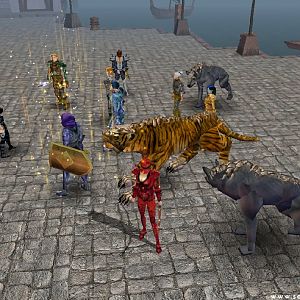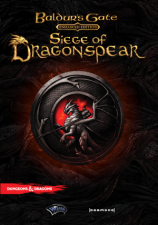Bard's Tale 1 Remastered Online Walkthrough by David Milward
ABOUT THE WALKTHROUGH
When one looks back at the earliest history of computer role-playing games, the Wizardry and Ultima and D&D Gold Box games are the most well known and celebrated series. The original Bard's Tale trilogy, released within the same time period, is often overlooked. Although fans of the series would argue that its contribution to the development of crpgs over time has been just as important, and they were just as fun to play as other more famous series.
The Bard's Tale Trilogy Remastered is a remake of the classics by Krome Studios that was initially available as a stretch goal for those who contributed to the crowd-funding of Bard's Tale 4. It is now available on either GOG or Steam. There are some things worth noting about the Remastered version of the trilogy.
For starters, it still plays very much like the games of the early history of crpgs. That is to say, it is a first-person dungeon crawler that will reward endless grinding for those who have the patience for it. And being a dungeon crawler, it does not have the joinable companions with backstories and the complex stories and morally complex choices that games of the new millenium constantly strive for. The first two games in particular are straight hack and slash, with not a lot in the way of story. Although there is, in my opinion, quite a poignant story in the third game.
Secondly, the game itself is an attempt to harmonize features across all three games instead of the incremental addition of features that you saw from first game to second and third. For example, all three games now have an auto-mapping feature where previously only the third had one. As another example, the first game required you to keep a special slot open for summoned monsters whereas the second and third games allowed you to have seven created party members at a time instead of just six. Sometimes items available in the first and second games would not import to the third, but now they do. For those with fond memories of the originals, there's also a Legacy Mode that allows you to play each game according to the specifics of the original game prior to the Remastered versions.
Combat will require some explanation, so I have a separate page for it here.
The guide is embedded with Youtube videos of my playthrough, with those videos accompanied by my explanations of what is going on and what decisions I am making.
PARTY MEMBERS AND THEIR DEVELOPMENT
As for my party, I designed my Heroes on the basis that they could be solid contributors to combat with the monsters during the gameplay itself, and yet also become credible members of the next pantheon of the gods at the conclusion of the trilogy. They are as follows:
- Lord Stygar, a Male Dwarven Paladin. He is destined to take over Kinestia as the new God of the Dwarves.
- Zarathos, a Male Half-Orc Fighter, who will become a Geomancer during the third game. He is destined to take over Malefia as the new God of Evil.
- Gallard, a Male Human Hunter. He is destined to take over Tarmitia as the new God of War.
- Ariel, a Female Half-Elf Bard. She is destined to take over Lucencia as the new Goddess of Love and Beauty. And yes, she's partially based on Ariel of Disney-fame.
- Cassandra, a Female Hobbit Rogue. She is destined to take over Tenebrosia as the new Goddess of Deception, Illusion and Trickery.
- Talia, a Female Elven Wizard, who will become the party's Chronomancer during the third game. She is destined to take over Arboria as the new Goddess of the Elves.
- Mordred, a Male Gnome Wizard. He is destined to take over Gelidia as the new God of Magic.
Bard's Tale 1 character generation involves the now-expected random rolls of stats on a 3-18 basis (here, there are five stats plus hit points). What is different about this game than most others in the genre is that, on each level up, a character will increase one of the five stats by 1, randomly picked from those stats not already at 18. What this means is that, ultimately, all characters will have 18's across the board. Thus, when generating a character, it is not crucial to re-roll for 10 minutes seeking that perfect roll. Instead, you roll a character to emphasize stats that are important to have as close to 18 as possible as early as possible, along with good starting hit points. For me, the only crucial stat for that purpose on non-casters is constitution. The reason for this is that, just as this game rewards significant grinding to achieve godly levels and equipment, it also rewards constant reloading on level-up until you are satisfied with the results. I save before leveling up my characters and reload until I am happy with my numbers, one character at a time. That means that there is a lot of reloading that does not appear on this guide. You can assume it happens though, trust me.
In my experience, warriors, paladins, hunters and bards can get at most 20 hit point on each level-up, and I generally will accept 18 without reloading. In addition, hunters also get a random increase to critical strike chance on each level up that seems to max out at 9. So, when I level up my hunter, I require a minimum of 17 HP and 7 critical strike or I reload and do it again. While I do not know necessarily if any stat weighs on the critical strike number, constitution definitely weighs on the hit point result. As I am not willing to have mediocre hit points on any level up, I make sure that constitution is as high as possible on ALL characters so that I can more easily obtain an acceptable hit point total on each level up. It is more difficult on rogues because their hit points seem to max out at around 10 each level, but they also obtain increases in the thieving skills each time as well, and it is important to swiftly level their disarm skill and their hide in shadows skill. Their identify skill is essentially insignificant because there are two vendors that can identify items for you for a price. As money swiftly becomes no object, and there's virtually nothing you find that you absolutely, positively, have to identify right then and there (all game crucial items are identified automatically when you find them), it's just as easy to have the items identified in Skara Brae. So, when leveling up my rogue, I aim for at least 8 hit points and at least 8 in both hide in shadows and disarm. I obviously prefer more, but I don't have the patience for 10 minutes of reloading just to get something like +9, +10, +10. I am a glutton for reloading punishment, but my masochism only goes so far.
On casters, I want high constitution and high intelligence on character creation and that's it. They have so many more levels that the rest due to the way the leveling and class changes for casters works that they reach all 18's before anyone else. What is more, their position on the back lines means that they never deal with combat in the first game, so their AC is unimportant, meaning that their dexterity is unimportant, and so is their strength. I basically want 17 or 18 in constitution and intelligence and I just don't care about the other stats on creation. The reason for the constitution is the same as any other character - higher HP on level ups. The reason for high intelligence is intuitive as well. High intelligence leads to a better chance of getting higher spell points on level up. For the first two classes (conjurer and magician) I am OK with at least 6 HP and at least 7 SP on each level up. For the second two classes (sorcerer and wizard), I aim for 10 HP and 7 SP on each level up.
Their adventure begins in the city of
Skara Brae.
ABOUT THE MAPS
All the maps in this solution are screen captures. When you see a smaller map, simply click on the thumbnail of the map to see the full version. All dungeon levels in the game are in a 22 x 22 square grid.
I sometimes refer to locations on a map with a notation of (insert number)N (insert number)E. The notation pinpoints the location as the number of squares north and the number of squares east of the square that is at the southwest corner of the map (which would make that square 0N 0E).
Note that it is also possible to loop from one side of the map to the other by passing through the edge of the map, provided that no wall is blocking your passage. For example, suppose you're standing at 15N 21E, and there's no wall on the east side of that square. If you step ahead east, you'll wind up at 15N 0E.
ABOUT THE AUTHOR
I’ve submitted past walkthroughs to Sorcerer’s Place as Dave Milward. My alias here, however, is Beren. If there’s anything you’d like to share with me, by all means you’re welcome to send me an e-mail to beren or contact me via PM on the SP message boards. If I find anything particularly helpful and worth mentioning specifically, I’ll give credit where credit is due in updates.
or contact me via PM on the SP message boards. If I find anything particularly helpful and worth mentioning specifically, I’ll give credit where credit is due in updates.
| Sorcerer's
Place is a project run entirely by fans and for fans. Maintaining
Sorcerer's Place and a stable environment for all our hosted sites requires a substantial amount of our time and funds on a regular basis, so please consider supporting us to keep the site up & running smoothly. Thank you! |


 or contact me via PM on the SP message boards. If I find anything particularly helpful and worth mentioning specifically, I’ll give credit where credit is due in updates.
or contact me via PM on the SP message boards. If I find anything particularly helpful and worth mentioning specifically, I’ll give credit where credit is due in updates.

